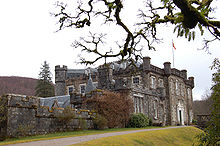Achnacarry Castle
Achnacarry Castle ( Scottish Gaelic : Achadh na Cairidh ) is a country house in the settlement of Achnacarry , about 15 miles northeast of Fort William at one end of Loch Arkaig in the Lochaber region of the Scottish Highlands . The original castle was built around 1655 and was destroyed in 1746 after the Battle of Culloden . A new country house in the Scottish Baronial Style was built in 1802 near the old castle.
Original castle
Ewen "Eoghainn MacAilein" Cameron , 13th chief of Clan Cameron , had the very controversial Gate Castle (which is said to be on Clan Mackintosh land ) built in the early 16th century . Tor Castle remained the seat of the Camerons of Lochiel until it was demolished by his great, great-great-grandson, Sir Ewen "Dubh" Cameron , 17th chief of the clan.
Sir Ewen Cameron wanted a "more comfortable" house, further away from Clan Macintosh, Clan Campbell, and Oliver Cromwell's garrison at Inverlochy Castle . Around 1655 he had Achnacarry Castle built in a strategically favorable location on the narrow road between Loch Lochy and Loch Arkaig. One of the few surviving descriptions describes Lochiel's seat as "a large house made entirely of fir, the finest of its kind in Great Britain". Sir Ewens Barde describes the house sometime around 1663 in a song as "The generous house of festivals [...] with pillars [...] hall of the princes [...], where wine freely goes around in shimmering glasses [...] with music echoes his rafts ”. Others portrayed the old Achnacarry Castle as the "home of men" with the feel and appearance of a large hunting lodge in the middle of the West Highlands.
After Sir Ewen's death in the early 18th century, his son, John Cameron of Lochiel , became chief of the clan. Soon afterwards his son Donald Achnacarry took over Castle when Lord Lochiel fled into exile in Flanders after the first Jacobite revolt .
From Donald Cameron of Lochiel ("The Gentle Lochiel"), the 19th clan chief, the best description of the property in Achnacarry has come down to us. In his marriage contract, it was stated as a duty that Lochiel should build his wife "a house [...] worth at least 100 pounds sterling with gardens, toilets, land and other amenities". Donald Cameron of Lochiel was planting a long line of beeches on the banks of the River Arkaig when news of " Bonnie Prince Charlie's " landing came in in 1745 ... this would be the last landscaping at Achnacarry Castle for years to come.
After the defeat of the Jacobite army at the Battle of Culloden in April 1746, the clans retreated to the Scottish Highlands and Donald Cameron took the lead in their regrouping. After this last attempt at resistance failed, he and his people fled to the mountains. On May 28, 1746, Donald Cameron watched men from Bligh's regiment and an independent group of Munros, led by George Munro, 1st of Culcairn , burn Achnacarry Castle to the ground. Many treasured relics and personal belongings were removed from the castle beforehand, but the magnificent, fir-wood-clad "old" Achnacarry Castle was then in ruins.
New Achnacarry Castle
In 1802, Achnacarry Castle, which was in ruins for about 50 years , was rebuilt as a Scottish Baronial style country house under Donald Cameron , 22nd chief of Clan Cameron. Nevertheless, the New Achnacarry Castle is still referred to as a castle. Donald's wife, Anne , née Abercromby , hired James Gillespie as the architect.
Achnacarry Castel has been rented out on various occasions. B. in August 1928 to the hunting enthusiast Henri Deterding , a very rich oil entrepreneur ( Royal Dutch Shell ) and personal financier of Hitler and Franco. On the occasion of the private hunting company held there, an oligopolistic cartel was established by Jersey Standard ( ExxonMobil ), Anglo-Persian Oil Company (BP) and Shell, the Achnacarry Agreement , which soon afterwards incorporated 15 other market-dominant US oil companies under the working title pool association in 1930 and 1934 it was again expanded and codified.
Second World War
The current building and the surrounding property became famous as the Commando Training Depot for the Allied forces from March 1942 to 1945. British commandos, United States Army Rangers and commandos from France , the Netherlands , Norway , Czechoslovakia , Poland and Belgium trained there. Each of the training courses culminated in an opposed landing exercise around the nearby Bunarkaig on Loch Lochy. There were also some deaths during training after live ammunition was used. According to the Daily Telegraph , about 25,000 commandos completed their training there in the four years that the training center existed. The country house was also damaged by fire. Various military associations sponsor a Commando March either annually or from time to time. Generally it is a temporary march in full war armament, backpack and military boots from Spean Bridge (the site of the Commando Memorial) to Achnacarry Castle.
Individual evidence
- ↑ Alexander MacKenzie: The History of the Camerons . BiblioBazaar 2008 reprint. 1883. Retrieved January 23, 2017.
- ↑ Matthieu Auzanneau: Or noir - La grande histoire du pétrole . 2nd Edition. No. 450 . Éditions La Découverte, Paris 2016, ISBN 978-2-7071-9062-8 , pp. 173-176, 201 f .
- ^ The Commando Basic Training Center at Achnacarry . 2015. Retrieved January 23, 2017.
- ↑ Major James Dunning - obituary . August 18, 2015. Retrieved January 23, 2017.
- ^ Commemorative Commando March . Combined operations. ( Memento from April 23, 2009 in the Internet Archive ).
Web links
- Spean Bridge Commando Memorial - Area of Remembrance
- Listed Building Entry . In: Historic Scotland .
- Listed Building Entry . In: Historic Scotland .
Coordinates: 56 ° 56 ′ 42.6 " N , 4 ° 59 ′ 53.5" W.

